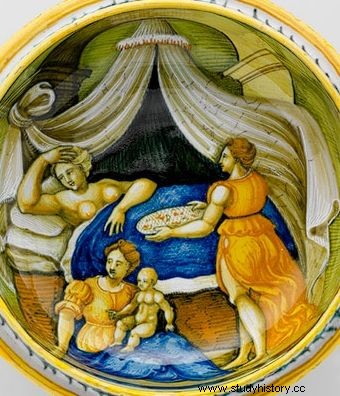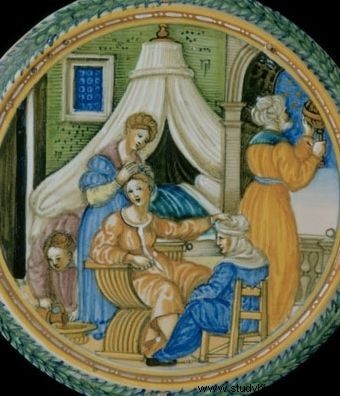If you are pregnant, you couldn't have come to a better place. We have great suggestions for you on how to prepare for the birth. You will need a brush, goose fat and an ax. And all this - tested 400 years ago.
We have the time of Bona Sforza and Barbara Radziwiłłówna, and you are just preparing for the birth. Where can you find professional guidelines? Of course, in the first Polish herbarium - "Hortus sanitatis, About herbs and their power" prepared by Stefan Falimirz (date of issue 1534). Apart from information on how to approximate the date of delivery, the author also provided a whole range of health and hygienic tips:
As early as ten days before the scheduled date a pregnant woman should go to a free bath and there, she has to sit in a bathtub of warm water until the time comes after washing off the dirt.> which water is to be seasoned with these softening herbs:

It's high time to prepare for the birth…
as mallow, scent blush, garden tall mallow, red rose with wreaths in the villages, called ibiscus in Latin, also put Mercurial (there is herb in the pharmacy) , watch.
Brew all this herb in the bathtub and every day you should infuse the pregnant lady's belt for nothing.
This treatment, designed to relieve pain and speed up the course of events, once labor begins is not for everyone. So if, dear future mother, you are in poor health, you can forget about relaxing baths.
Instead, use the broth above as a poultice on anything below your waist. Not forgetting his feminine attributes in particular.
Take care of an intimate beauty
Now that you are in the ninth month, you are about to face a difficult task that can be summed up in a fruit metaphor. You need to push the watermelon through a lemon-sized hole. Falimirz advises:prepare her well for this.
At the end of the last trimester, pregnant women were advised to lubricate the perineum with various substances to moisturize and soften the area. The author of "Hortus Sanitatis" explained:
For this purpose you had almond, blush, violet, coconut, duck and goose oils, and smudged these things with all secret places.
In case the woman was of barzo nature dry , said preparation had to be inserted into the vagina with a suitable tampon and removed after three hours.

Birth in a Renaissance style.
Similarly today, it is recommended to moisturize the intimate areas, and additionally lubricate the stretch marks-prone areas with appropriate preparations. If necessary, you can always use the wonderful old Polish mix of poultry lard with fragrant oils.
Following the example of 16th and 17th century obstetricians, also avoid cold, sour and bitter meals in the last days of pregnancy . It is enough to add a little bit of gymnastics to it and you can give birth.
Keep Calm and Call the Midwife!
When the first contractions appear, the panicked parents jump in the car and rush at breakneck speed to the hospital.
Usually, they spend many hours in this tabernacle before the baby is born, assisted by midwives and doctors. In modern times, the woman in labor did not go through everything alone. As Bożena Zaborowska, the author of the work "Help with births in the Commonwealth in the modern era" writes:
Next to surgery, obstetrics is the oldest branch of medicine. From the dawn of time, the need for a midwife's help was self-imposed and was dictated not only by the desire to relieve the child in labor, but also by concern for the child's life, which was an expression of the compulsion to preserve the species.
The whole act of the birth of a child was surrounded by an aura of mystery. Hence the birth rituals bordering on magic (spells, spells, amulets) and various superstitions. In addition to these practices, astrologers, whose wisdom was taken very seriously during the Renaissance, were of course adding their pennies.
Don't forget to open all drawers!

Childbirth in Renaissance Italy.
If you want to make your childbirth easier with the help of the magic of that time, Wiktor Piotrowski, author of "Medicine of the Polish Renaissance" has some suggestions for you:
It was recommended that obstetricians hold an eagle stone, black amber or agate in their hands, open doors, windows, drawers and wardrobes at home, touch the birth head with an ax. >
Similar superstitions were gradually displaced by specific medical knowledge and practice. Textbooks of obstetrics appeared and even the first school of midwives was opened in a Parisian hospital in 1640 with the maternity ward.

A birthing stool. Renaissance portrayal of the birth act.
Ironically, in an era when, at least in Poland, the progressive renaissance gave way to xenophobic and parochial Sarmatism, the art of giving birth was a field in which expertise was the basis.
Go to Paris… like Marysieńka
Taking into account the high level of obstetrics in France at that time, it is hardly surprising that Marysieńka Sobieska went there without fear when she was pregnant. And she survived some of her numerous births on the spot.
On the other hand, she also had the best care on the Vistula, after all, she gave birth - still as Mrs. Zamoyska - under the care of Queen Ludwika Maria Gonzaga. She gave birth to seventeen children in total, so it can be said that she knew her stuff.

Marysieńka Sobieska. A real expert on childbirth!
Throughout the Baroque period, it was in the hands of qualified women to bring children into this world. When everything was going well, the woman in labor was simply looked after by a midwife, also known as a baba, or a grandmother. Also you, dear mother, do not panic if only the midwife is looking after you. It means everything is fine. Maybe just - don't call her "baba".
Midwife's nail
All the time, the midwife's task was to calm the obstetrician, persuade that she would give birth to a son (daughters were generally considered less “valuable” offspring), and at the right moment to encourage the enormous effort. A pregnant woman was often placed on the birthing stool who nowadays returns to maternity wards after years of exile.
The midwife supported the woman in labor and often at the same time had to cause her pain. The assisting woman's task was to compress the fundus in order to speed up labor and, if necessary, manual correction of the position of the fetus. In this case, it was recommended to lubricate the skin of the hands well, which facilitated the operation. At the right moment, the midwife would also break the fetal bladder (usually with a fingernail or with a sharp instrument that was far from sterile) .
When the newborn finally left its mother's belly, it landed right in the midwife's hands. She cut off and tied the umbilical cord, and then, as Bożena Zaborowska writes:
She gave it to the other women accompanying the delivery - it was their responsibility to wash and give birth to the baby.
For the midwife, the work did not end there. Now she had to make sure that the woman gave birth to the placenta and membranes. By pulling on a newly cut umbilical cord, she helped the newborn mother expel everything and made sure that the uterus was completely emptied.

Childbirth in an 18th century French illustration.
It was especially important because of possible very dangerous complications in case any fragment remained inside. The midwife knows what she is doing.
You have to get cut up sometimes
If something goes wrong, don't lose your head. Sometimes you have to seek help elsewhere. Modern authors of medical handbooks recommended that the midwife summon a doctor in case of complications. Wprost wrote about this Polish 17th-century physician Piotr Cziachowski:
never trusting each other and took the other, and even summoned third and fourth doctors.
His knowledge and practice could prove crucial. If the baby was not positioning correctly, the doctor might have turned it over. When the obstetrician did not have the strength to push, could use the birthing forceps introduced in the 16th century and pull the baby out.
But sometimes things got really bad and the doctor had to resort to drastic measures.
A pig slaughterhouse will do a caesarean
Already in the legislation of ancient Rome from the time of Numa Pompilius, there was a provision on the compulsory removal from the body of a pregnant mother who had died during pregnancy. The procedure was performed by incising the abdominal wall and taking the child out. Today it is called caesarean section, from Latin sectio caesarea .
As Władysław Szumowski, author of the "History of Philosophically Approached" writes, in the 15th century it was supposed to be carried out by a certain Swiss.

"Family Scene with Newborn" by Esaias Boursse (1665-1670).
Jakub Nufer, pig keeper ( orcheotomus ) from Siegershausen, in the canton of Thurgau. He applied to the authorities with a request that he be allowed to perform a caesarean section on a wife who cannot give birth to a child and for whom the help of midwives is not enough. When he was granted permission, Nufer performed a caesarean section "not unlike a pig, by the veterinary method" .
This operation allegedly ended more than well:the mother and child survived. Moreover, the woman was to give birth to several more children by force of nature in the future. Considering the state of medicine at the time, it is hard to believe. The operation from the beginning of the 17th century is considered the first reliably documented cesarean section saving the mother and child. A certain Jeremiah Trautmann made it in Wittenberg in 1610.
